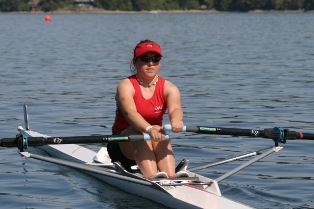Learning to scull is like learning to dance
 Hamburg - "This is the workplace," says Carsten Dietrich pointing to a long, narrow row boat.
Hamburg - "This is the workplace," says Carsten Dietrich pointing to a long, narrow row boat.
Two thin metal rails affixed with a sliding plastic seat are where Dietrich is pointing. In front of it are two slanted boards with straps for the feet. At first glance, the contraption seems more like a rowing machine in a dreary fitness centre than something that could be used for a summer outing along river.
Indeed, learning to row requires study that has to be placed ahead of the goal of getting out and enjoying nature, said Dietrich, an instructor with Hamburg's sculling club. Using oars in an ordinary rowboat is simple compared with learning to scull, which requires taking a course lasting several weeks. And there are good reasons for that, said Rudolf Loeffler, youth trainer at Dresden's scull club 1902.
Sculling is a team sport enjoyed by many people around the world. Therefore, learning it correctly is essential to its enjoyment.
To begin with, beginners must learn how to use their bodies correctly, said Kathrin Fister, who is head of a sculling club within the water sport department at a Hamburg high school. The motoric challenges lie in the many movements that follow one another and that must be coordinated and memorized.
"It's just like taking a dance course. You've first got to learn the routine steps before you can dance," said Fister.
Generally, anyone can learn to scull, Dietrich said. There are a few prerequisites, though. The ability to swim is first and utmost, a bit of conditioning and strength doesn't hurt either. But a beginner doesn't have to have a muscular build. As opposed to sheer strength, fine motoric skills and the ability to use one's head are necessary attributes.
"Women often initially catch on better simply because they listen," said Balthaser Iblher of the Alster sculling club Hanseat in Hamburg. Men often start off by breaking a cardinal rule. They try to make up for technical mistakes by using power and in doing so lose their balance. And then they fall headlong into the water, said Iblher.
That's why Dietrich lets beginners get their first taste of rowing in March on a calm Alster canal in a stable four-gig boat, pointing to an old scuffed up boat.
"We take double-keel boats like this, which lie on the water like barque and nothing can happen," Dietrich said. During the course, newcomers move to smaller and more technically advanced boats as a motivation and a reward for their progress.
The sculling sessions on the Alster canals get longer as spring advances until the learners reach the outer Alster in May. At the end of the course those who want to discover the lure of rowing by taking a longer final trip, Dietrich said. Completing the course gives participants the knowledge and experience they need to row anywhere in the world. But their workplace will always look the same.